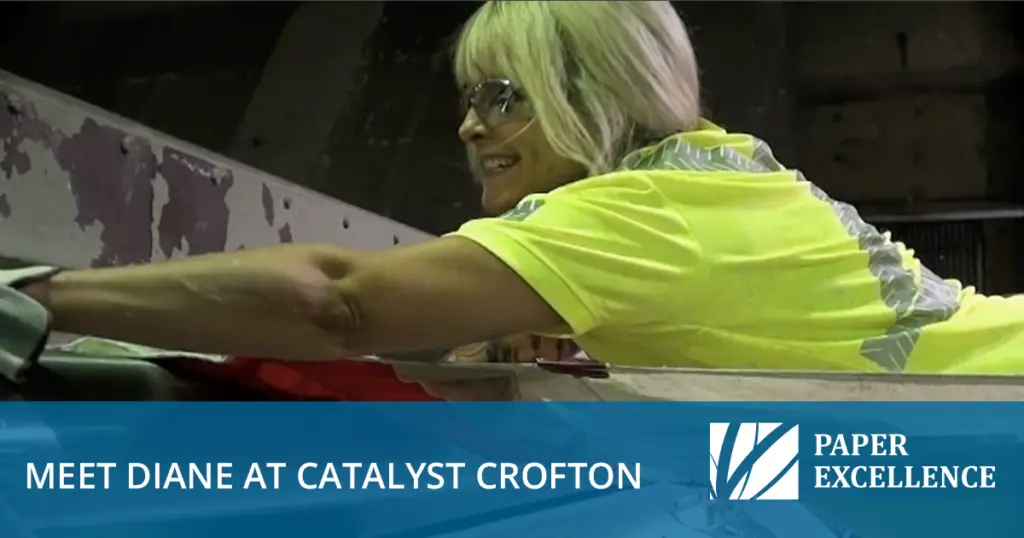
Diane Gladman was profiled on the Forestry Friendly Communities website earlier this month. As March wraps up, we wanted to share Diane’s full profile here. Diane is a great example of a multi-generational forestry family who is currently living the industry’s sustainability story.
In your role, what are your responsibilities? What does your typical day look like?
I’ve worked the Crofton mill for 22 years and have worked my way up through the mill. Right now, I take care the dry end of the pulp machine. The goal is to get the pulp sheet through the drier, cut into bales, weighed, wrapped, stacked and out to the warehouse to by unitized with as few problems as possible.
I am constantly assessing the pulp machine and looking for issues. When something goes wrong, I need to work with my crew to identify the issue. Then we either troubleshoot it ourselves or identify who we need to call in to fix the issue.
I’m also responsible for adjusting the steam system when the pulp machine changes speeds and I do the quality control testing to ensure the pulp meets our customers’ standards. In those tests I’m looking for brightness, density and contaminates like dirt or plastic.
How did you get your start in forestry?
My family has been involved in forestry on Vancouver Island for four generations. My great grandparents had a phone and owned the last house on the road to the logging camp outside Courtenay. People used to come out of the camp to use their phone and my grandparents took messages for the camp. My grandparents sold dynamite to logging contractors. One of my uncles worked at Crofton when the mill originally opened in 1957. My dad and my brother both delivered wood chips to the Crofton mill as truck drivers. These days, my brother drives a logging truck.
My dad passed away just as I was starting my career, but it was working with him on his backyard mechanic projects when I was kid that first developed my mechanical skills. Originally, I trained as a plumber and moved to Vancouver to work for BC Gas. After a while, I wanted to move back home to the Island to raise my family. But I still wanted a job that paid well, and I wanted to stay in an industrial environment. So, I sent my resume to the mill and got hired.
What do you love about your job?
I love working as part of a crew. Generally, there are eight people on a crew. When there’s a problem with the pulp machine, everyone pitches in to troubleshoot it. I’ve met some really cool people over the years through working on crews.
I also enjoy the shift work. I work four days on (two days, two nights) followed by four days off. So, if I take four days of vacation, I get 12 days off. And there’s also the money, benefits, pension plan which are important to me.
What work-related accomplishments are you most proud of?
I am very proud of my involvement in safety and training at the mill. My son is a videographer and he and I made of bunch of safety and training videos that the mill still uses. Once you’re in the mill, it’s so loud that it’s hard to explain to people what’s happening. Being able to show employees a video of a running pulp machine and the issues that arise is a big help. My son and I left a legacy there.
What excites you about your future in this industry?
The history—my family has been involved in this industry for such a long time. And the future—this industry has such a great sustainability story.
What advice would you give to women who might be considering a career in forestry?
I’d give this advice to anyone, not just women. Really find out what you’re getting yourself into. The mill is loud and humid, and the shifts are 12 hours long. It can also be scary being around big machinery all the time—you always need to be aware of your surroundings. That said, I encourage women to get involved in any trade. When you fix something or figure something out, there’s a great feeling of accomplishment. I’ve had lots of moments where I’ve solved a problem and felt, “Yeah, I can do this!”
What’s you perspective on sustainability in the industry?
Between my brother and me, we are living forestry’s sustainable, value-added, circular economy. My brother owns a logging truck with a self-loader. He hauls the logs from the cutblock to the sawmill. The sawmill makes lumber and then sells its waste (bark and wood chips) to the pulp & paper mill just down the highway. With those two waste products, I help produce one of the two value-added forest products the Crofton mill makes – pulp and paper.
